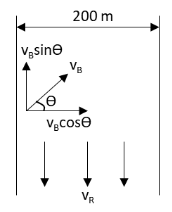Question
Question: A boat crosses a river of width \[200\,{\text{m}}\] in the shortest time and is found to experience ...
A boat crosses a river of width 200m in the shortest time and is found to experience a drift of 100m in reaching the opposite bank. The time taken is now ‘t’. If the same boat is to cross the river by the shortest path, the time taken to cross will be:
A. 2t
B. 2t
C. 3t
D. 32t
Solution
Use the formula for velocity of an object. Write the equation for velocity of the boat and velocity of the river. Then draw the diagram representing the velocities of the river and boat. Then from this diagram determine the resultant velocity of the boat to cross the river. Hence, determine the time required to cross the river.
Formula used:
The velocity v of an object is given by
v=ts …… (1)
Here, s is the displacement of the object and t is time.
Complete step by step answer:
We have given that the width of the river is 200m and drift experienced by the boat is 100m.
w=200m
⇒d=100m
The time taken by the boat to cross the river is t. We have asked to determine the time taken by the boat to cross the river by the shortest path.Let vR and vB be the velocities of the river and boat.According to equation (1), the velocity of the boat to cross the river by shortest path is
vB=t200m …… (2)
The boat experiences the drift due to velocity of the river given by
vR=t100m
Let us now draw the diagram showing the velocities of the boat and river.

From the above diagram, we can see that the velocity of the river gets cancelled by the vertical component of velocity of the boat.
vR=vBsinθ
Substitute t100m for vR and t200m for vB in the above equation.
t100m=t200msinθ
⇒sinθ=21
⇒θ=30∘
The velocity v of the boat while crossing the river by shortest path is the horizontal component of velocity of the boat vBcosθ.
v=vBcos30∘
From equation (2). We can write
t′=v200m
Here, t′ is the time required to cross the river.
Substitute vBcos30∘ for v in the above equation.
t′=vBcos30∘200m
Substitute t200m for vB in the above equation.
t′=t200mcos30∘200m
⇒t′=t200m23200m
∴t′=32t
Therefore, the time required for the boat to cross the river by shortest path is 32t.
Hence, the correct option is D.
Note: The students should keep in mind the velocity of the river causes the boat to experience the drift. Hence, one should not forget to consider the velocity of the river and this drift of the boat. Also the students should keep in mind that the vertical component of velocity of the boat gets cancelled with velocity of the river. Hence, the only velocity of the boat is its horizontal component.
